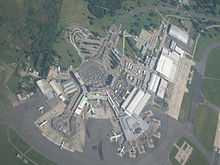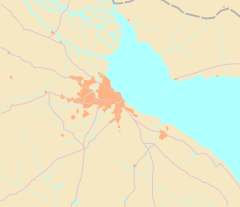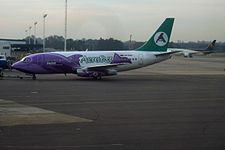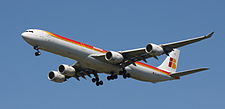- Ministro Pistarini International Airport
-
Ministro Pistarini International Airport
Aeropuerto Internacional Ministro Pistarini
Aerial view of the airport 
Main concourse at Terminal A IATA: EZE – ICAO: SAEZ Location of airport in Buenos Aires Summary Airport type Public Owner Argentine Government (Minister of Federal Planning and Public Utilities) Operator Aeropuertos Argentina 2000 Serves Buenos Aires Location Ezeiza, Argentina Hub for - Aerolíneas Argentinas
- LAN Airlines and affiliates
- SkyTeam (2012)
Elevation AMSL 21 m / 67 ft Coordinates 34°49′20″S 58°32′09″W / 34.82222°S 58.53583°WCoordinates: 34°49′20″S 58°32′09″W / 34.82222°S 58.53583°W Website Runways Direction Length Surface m ft 11/29 3,300 10,827 Asphalt 17/35 3,105 10,187 Asphalt Statistics (2010) Total Passengers 8,786,807 Aircraft Movement 93,346 AIP,[1] ORSNA[2]
Passenger statistics from Aeropuertos Argentina 2000.[3]Ministro Pistarini International Airport (Spanish: Aeropuerto Internacional Ministro Pistarini) (IATA: EZE, ICAO: SAEZ), more commonly known as Ezeiza International Airport owing to its location within the Ezeiza Partido in the Greater Buenos Aires, is an international airport located 22 km (14 mi) south-southwest of Buenos Aires,[1] the capital city of Argentina. It is the country's largest international airport by number of passengers handled —85% of international traffic—,[2] and serves as a hub for the international services of Aerolíneas Argentinas and LAN Argentina. Covering an area of 3,475 hectares (8,590 acres),[2] the airport serves both the city of Buenos Aires and its metropolitan area. It is operated by Aeropuertos Argentina 2000 S.A. since 1998.[1][4][5]
Ministro Pistarini Airport was voted “2007 best airport in the region” following a survey carried out by Skytrax.[6] However, it shifted to the third place in 2010, behind Arturo Merino Benítez International Airport and Jorge Chávez International Airport.[7]
Contents
History
The airport was named after the general and politician Juan Pistarini (1882–1956). The first civilian flight from what is now London Heathrow Airport, a BSAA Avro Lancastrian, flew to Ministro Pistarini International Airport in 1946.
Completely designed and erected by Argentine technicians,[8] the airport was built between 1945 and 1949.[citation needed] Its construction was one of the major projects included in the five-year plan of the first presidence of Juan Perón.[8] At the time it was inaugurated it was the largest airport in Latin America,[citation needed] the third largest in the world,[9] and the only one with three crossed runways (05/23, 11/29 and 17/35) that resembled the shape on an equilateral triangle. In 1997, RWY 05/23 was closed, and now it is used for large aircraft (such as the Airbus A340 or Boeing 747) for parking while cleaning and refueling.
The Ezeiza massacre took place in the airport in 1973.[10]
Accesibility
The Riccheri Motorway connects the airport with downtown Buenos Aires. There are no rail links between the airport and the city. The closest rail station is Ezeiza, the railway line passing through it having Constitución station as terminus. Ezeiza station can be reached by bus number 518. Other bus lines entering the terminal are the 8, 51 and 394. The first of them offers a semi-rapid service between the airport and downtown Buenos Aires that partly runs through the Riccheri Motorway, whilst the other two links the airport with several cities located within the southern Buenos Aires metropolitan area. Although the service offered by these buses is cheap, passengers with large luggage are often not carried as the buses lack luggage capacity. Another way of accessing the terminal is by taxi or by a number of charter buses.
Operations
This airport was collecting an Airport Improvement Fee of US$29 as of 7 September 2009[update], payable before any international departure. This fee is now required to be included in the price of the ticket.
Effective December 2009, citizens from countries requiring Argentine people a visa to enter its territory —including Australia, Canada and the United States, among others— are levied a “reciprocity rate” on arrival to the airport; payable in Argentine pesos or dollars, the amount collected depends upon the nationality of the inbound passenger, and is equivalent to the price Argentine citizens have to pay in order to get a visa from such countries.[11]
In 2010, the airport handled 8,786,807 passengers.
Terminals, airlines and destinations
New terminal C was inaugurated in July 2011;[12] the only carrier making use of its facilities is Aerolíneas Argentinas, as of July 2011[update].[13][14] SkyTeam members are expected to migrate their operations to the terminal in the future.[15]
Passenger airlines
Airline operations at the airport
AeroSur connects the airport with Santa Cruz de la Sierra.American Airlines links the airport with three destinations within the United States.Varig used to have important-standing operations in the airport. The airline is owned by Gol Transportes Aéreos, and links the airport with a number of Brazilian cities.Airlines Destinations Terminal Aerolíneas Argentinas Auckland, Barcelona, Bogotá, Caracas, Córdoba,[16] Lima, Madrid, Mendoza,[16] Mexico City, Miami, Rio de Janeiro-Galeão, Rome-Fiumicino, Santa Cruz de la Sierra-Viru Viru, Santiago de Chile, São Paulo-Guarulhos, Sydney
Seasonal: Cancún, Punta CanaB, C Aeroméxico Mexico City A AeroSur Santa Cruz de la Sierra-Viru Viru A Air Canada Santiago de Chile, Toronto-Pearson A Air Europa Madrid A Air France Paris-Charles de Gaulle A Alitalia Rome-Fiumicino A American Airlines Dallas/Fort Worth, Miami, New York-JFK A Avianca Bogotá A Boliviana de Aviación Cochabamba, La Paz, Santa Cruz de la Sierra-Viru Viru A British Airways London-Heathrow A Continental Airlines Houston-Intercontinental A Conviasa Caracas A Copa Airlines Panama City A Cubana de Aviación Havana, Varadero
Seasonal: Cayo CocoA Delta Air Lines Atlanta A Emirates Dubai [begins 3 January],[17] Rio de Janeiro-Galeão [begins 3 January][17] A Gol Transportes Aéreos Asunción, Belo Horizonte-Confins, Curitiba-Afonso Pena, Florianópolis, Porto Alegre, Rio de Janeiro-Galeão, Santiago de Chile, São Paulo-Guarulhos A Iberia Madrid A KLM Amsterdam A LAN Airlines New York-JFK, Santiago de Chile A LAN Argentina Lima, Miami, Punta Cana A LAN Ecuador Guayaquil, Quito A LAN Perú Lima A Lufthansa Frankfurt A Malaysia Airlines Cape Town, Kuala Lumpur A PLUNA Montevideo A Qantas Sydney [ends 24 March 2012][18] A Qatar Airways Doha, São Paulo-Guarulhos A Sky Airline Santiago de Chile A South African Airways Johannesburg A TACA Airlines operated by Lacsa Lima A TACA Perú Lima A TAM Airlines Belo Horizonte-Confins, Recife, Rio de Janeiro-Galeão, Salvador da Bahia, São Paulo-Guarulhos A TAM Airlines Paraguay Asunción, Rio de Janeiro-Galeão A United Airlines Newark [begins 7 April 2012][19][20], Washington-Dulles [ends 6 April 2012][21] A Cargo airlines
Airlines Destinations Air Class Montevideo-Carrasco Aerovip Cargo Montevideo-Carrasco, Punta del Este Centurion Air Cargo Miami Cielos Airlines Lima FedEx Express Campinas-Viracopos, Memphis, Santiago de Chile Florida West International Airways Bogotá, Miami LAN Cargo Asunción, Bogotá, Campinas-Viracopos, Frankfurt, Miami, Santiago de Chile, Lufthansa Cargo Campinas-Viracopos, Dakar, Frankfurt MasAir Mexico City Martinair Cargo Amsterdam, London-Stansted, Miami UPS Airlines Miami, Campinas-Viracopos Statistics
Traffic 2010 2009 2008 2007 2006 2005 2004 2003 2002 2001 2000 Passengers 8,786,807 7,924,759 8,012,794 7,487,779 6,867,596 6,365,989 5,567,544 4,891,038 4,087,553 5,190,283 6,196,975 Cargo (tons) 248,692 189,692 205,506 204,909 187,415 177,358 174,890 141,042 117,190 160,698 198,291 Accidents and incidents
As of August 2011[update], Aviation Safety Network records 30 accidents/incidents for aircraft that departed from the airport or had it as a destination.[22] The list below provides a summary of the fatal events only.
Accidents involving fatalities
- 16 July 1956: An Aerolíneas Argentinas Douglas C-47A-25-DK, registration LV-ACD, that was operating a domestic scheduled Ezeiza–Río Cuarto passenger service, crashed while en route into the terrain 5 kilometres (3.1 mi) northeast of Pavín, Córdoba, Argentina, when the aircraft descended below the prescribed altitude. Eighteen people lost their lives.[23]
- 8 December 1957: Aerolíneas Argentinas Flight 670, a Douglas DC-4, tail number LV-AHZ, that was due to operate a scheduled domestic Ezeiza–Bariloche passenger service, crashed 25 kilometres (15.5 mi) southeast of Bolívar, Buenos Aires, Argentina, after the loss of control of the aircraft when it encountered unfavorable weather conditions. The accident claimed 61 lives.[24][25]
- 25 February 1960: The 1960 Rio de Janeiro air crash involved two aircraft —one of them having departed from Ezeiza Airport— in a mid-air collision that ended up with both airplanes crashing into the Guanabara Bay. A US Navy Douglas R6D-1, registration 131582, that had departed from Buenos Aires-Ezeiza bound for Galeão Air Force Base collided over Rio de Janeiro with a Real Transportes Aéreos Douglas C-47A-25-DK, tail number PP-AXD. The first aircraft was on approach to Galeão, while the second one was on approach to Santos Dumont Airport. The death toll rose to 61, with 35 reported fatalities from the American airplane, and all 26 occupants of the Brazilian aircraft.[26][27][28]
- 18 May 1960: A Transamerican Air Transport Curtiss C-46F-1-CU Commando, registration LV-GGJ, that was due to operate a Buenos Aires–Santiago–Lima cargo service, crashed en route its first leg into the terrain after it encountered severe turbulence on the flight path. There were 10 reported fatalities.[29]
- 7 September 1960: Aerolíneas Argentinas Flight 205, a Douglas DC-6, tail number LV-ADS, that was operating an international scheduled Silvio Pettirossi International Airport–Ezeiza Airport, suddenly crashed 12 kilometres (7.5 mi) east-northeast of Salto, Uruguay. All 31 occupants of the aircraft lost their lives.[30][31][32]
- 19 July 1961: Aerolíneas Argentinas Flight 644, a Douglas DC-6, registration LV-ADW, that was due to operate a domestic scheduled Ezeiza–Comodoro Rivadavia passenger service, broke up and crashed 12 kilometres (7.5 mi) west of Pardo, Buenos Aires, Argentina, after it entered a region of severe turbulence. All 67 occupants of the airplane perished in the accident.[33]
- 6 February 1965: Lan Chile Flight 107, a Douglas DC-6B, registration CC-CCG, that operated an international scheduled Los Cerrillos Airport–Ezeiza passenger service, struck mountaineous terrain in the Andes, near the San José Volcano. There were 87 reported fatalities.[34][35][36]
- 17 August 1966: An Aerovías Halcón Curtiss-C-46F-1-CU Commando, tail number LV-GLA, that was due to operate a domestic non-scheduled Río Gallegos–Ezeiza passenger service, water-landed near Puerto Lobos, Chubut, Argentina, following the impairment of both engines, and hit some rocks while travelling over the water. An occupant of the aircraft died in the accident.[note 1]
- 23 October 1996. Fuerza Aérea Argentina Flight 5025, a Boeing 707-372C, registration LV-LGP, that was operating a cargo service, struck the ground short of the runway on final approach to Ezeiza inbound from Arturo Merino Benítez International Airport, breaking up and bursting into flames. Two occupants of the aircraft lost their lives.[39][40]
- 26 October 2003: CATA Línea Aérea Flight 760, a Fairchild FH-227B, tail number LV-MGV, operating a non-scheduled Ezeiza–Camba Puntá Airport freighter service, encountered technical difficulties shortly after take off from Ezeiza Airport and attempted a belly landing on a nearby golf course. The aircraft skidded some 200 m in doing so before hitting a tree and bursting into flames. All five occupants of the aircraft perished in the accident.[41][42]
Incidents involving fatalities
- 27 July 1952: Pan Am Flight 201, an international scheduled New York–Rio de Janeiro–Buenos Aires passenger service operated with a Boeing 377 Stratocruiser 10-26, tail number N1030V, experienced a sudden depressurisation following the opening of a cabin door while en route between Galeão International Airport and Ezeiza Airport; a woman passenger was blown out of the aircraft.[43]
Notes
- ^ There exists a discrepancy on whether the recorded fatality corresponded to a passenger,[37] or to a crewmember.[38] There also exists a discrepancy on the date the accident occurred.[37][38]
References
- ^ a b c "SAEZ/Ezeiza Ministro Pistarini fact sheet" (in Spanish). AIP. http://www.cra.gov.ar/dta/ais/aip/docs/124.pdf. Retrieved 16 July 2011.
- ^ a b c "Organismo Regulador del Sistema Nacional de Aeropuertos" (in Spanish). http://www.orsna.gov.ar/. Retrieved 16 July 2011.
- ^ Airport statistics for 2008 from Aeropuertos Argentina 2000
- ^ "Argentina Transfers International Airport Today". Business News Americas. 27 May 1998. http://www.bnamericas.com/news/privatization/Argentina_Transfers_International_Airport_Today. Retrieved 28 July 2011.
- ^ Tom Gill (1 March 1998). "Milan moves in to manage". Flightglobal.com. Airline Business. http://www.flightglobal.com/articles/1998/03/01/33517/milan-moves-in-to-manage.html. Retrieved 28 July 2011.
- ^ "Ezeiza chosen as best airport in the region; Santiago second". MercoPress. 6 September 2007. http://en.mercopress.com/2007/09/06/ezeiza-chosen-as-best-airport-in-the-region-santiago-second. Retrieved 23 August 2011.
- ^ "Lima and Santiago airports are Latin America’s leaders". MercoPress. 30 December 2010. http://en.mercopress.com/2010/12/30/lima-and-santiago-airports-are-latin-america-s-leaders. Retrieved 23 August 2011.
- ^ a b "CIVIL AVIATION NEWS" (pdf). Flight: 731. 8 December 1949. http://www.flightglobal.com/pdfarchive/view/1949/1949%20-%201965.html. Retrieved 16 July 2011. "PERON'S PRIDE: Probably the largest and most modern air terminus in the world, the new "Ministro Pistarini" airport at Buenos Aires is one and a half time as big as London Airport. Covering an area of 19 square miles, it has three runways, one of which is 3,060 yards in length, and is capable of accommodating aircraft up to 150 tons in weight. The airport was designed and built entirely by Argentinian technicians and is one of the major projects in General Peron's five-year plan."
- ^ "Civil Aviation News..." (pdf). Flight: 494. 21 October 1948. http://www.flightglobal.com/pdfarchive/view/1948/1948%20-%201770.html. Retrieved 16 July 2011. "Work on the new airport at Ezeiza, near Buenos Aires, is nearly completed and, provisionally, it will be in operation at the end of the year. Covering 18,600 acres, it is claimed to be the third largest international airport in the world."
- ^ Germán Sopeña (22 June 1998). "Hace 25 años, la masacre de Ezeiza enlutaba a la Argentina [The Ezeiza massacre mourned Argentina 25 years ago]" (in Spanish). La Nación. http://www.lanacion.com.ar/100886-hace-25-anos-la-masacre-de-ezeiza-enlutaba-a-la-argentina. Retrieved 17 July 2011.
- ^ "Argentina begun enforcing “reciprocity tax” in Ezeiza airport". MercoPress. 29 December 2009. http://en.mercopress.com/2009/12/29/argentina-begun-enforcing-reciprocity-tax-in-ezeiza-airport. Retrieved 23 August 2011. "All foreign visitors arriving in Argentina’s international airport of Ezeiza and who live in countries that charge the Argentines before they enter, will have to pay a reciprocity tax."
- ^ Loreley Garffoglio (7 July 2011). "Ezeiza estrena una nueva terminal [Ezeiza's new terminal commences operations]" (in Spanish). La Nación. http://www.lanacion.com.ar/1387486-ezeiza-estrena-una-nueva-terminal. Retrieved 17 July 2011.
- ^ "Aerolíneas estrenó la Terminal C [Aerolíneas commenced operations in terminal C]" (in Spanish). La Nación. 17 July 2011. http://www.lanacion.com.ar/1389655-aerolineas-estreno-la-terminal-c. Retrieved 17 July 2011.
- ^ Josefina Pagani (15 July 2011). "Comenzó a operar ayer la nueva terminal C en Ezeiza [Ezeiza's new terminal C started operations yesterday]" (in Spanish). La Nación. http://www.lanacion.com.ar/1389642-comenzo-a-operar-ayer-la-nueva-terminal-c-en-ezeiza. Retrieved 17 July 2011.
- ^ "AEROLINEAS ARGENTINAS BEGINS FLIGHTS TO THE NEW TERMINAL AT EZEIZA" (Press release). Aerolíneas Argentinas. 12 July 2011. http://www.aerolineas.com.ar/arg/main.asp?idSitio=AR&idPagina=68&idIdioma=en&cmbPrensa=1052. Retrieved 17 July 2011. "Terminal “C” also has an exclusive VIP lounge, called “Salon Condor”, especially designed to meet the requirements determined by the Sky Team Alliance, of which Aerolineas Argentinas is becoming a member. The VIP salon will not only be used by Aerolineas Argentinas’ passengers but also by the passengers on all airlines in the alliance."
- ^ a b "New Aerolíneas Argentinas flight from Ezeiza to Cordoba and to Mendoza" (Press release). Aerolíneas Argentinas. 13 May 2009. http://www.aerolineas.aero/arg/main.asp?idSitio=AR&idPagina=68&idIdioma=en&cmbPrensa=655. Retrieved 28 May 2011. "Aerolíneas Argentinas will start operating the route Ezeiza- Cordoba - Mendoza, from July 1st, onwards."
- ^ a b "Emirates expands South American network with flights to Buenos Aires and Rio de Janeiro". Emirates. 6 April 2011. http://www.emirates.com/english/about/news/news_detail.aspx?article=658200&offset=0. Retrieved 10 July 2011.
- ^ John Walton (30 September 2011). "Qantas flights move from Buenos Aires to Santiago in March 2012". http://www.ausbt.com.au/qantas-flights-move-from-buenos-aires-to-santiago-in-march. Retrieved 30 September 2011.
- ^ http://www.united.com/press/detail/0,7056,69234,00.html
- ^ http://travel.usatoday.com/flights/post/2011/11/united-tweaks-international-routes/563030/1?csp=34travel
- ^ http://travel.usatoday.com/flights/post/2011/11/united-tweaks-international-routes/563030/1?csp=34travel
- ^ Accident history for Ezeiza-Ministro Pistarini Airport at Aviation Safety Network
- ^ Accident description for LV-ACD at the Aviation Safety Network. Retrieved on 13 August 2011.
- ^ Accident description for LV-AHZ at the Aviation Safety Network. Retrieved on 29 July 2011.
- ^ "Timeline: Worst air accidents in Argentina". Buenos Aires Herald. 19 May 2011. http://www.buenosairesherald.com/article/67564/timeline-worst-air-accidents-in-argentina. Retrieved 29 July 2011.
- ^ Accident description for US Navy DC-6 131582 at the Aviation Safety Network. Retrieved on 29 July 2011.
- ^ Accident description for PP-AXD at the Aviation Safety Network. Retrieved on 29 July 2011.
- ^ "TWO TRAGEDIES" (pdf). Flight: 319. 4 March 1960. http://www.flightglobal.com/pdfarchive/view/1960/1960%20-%200319.html. Retrieved 29 July 2011. "In rain and mist on the afternoon of February 25, a REAL DC-3 and a US Navy R6D (DC-6) carrying US Navy bandsmen and anti-submarine personnel collided below the Sugar Loaf Mountain and crashed into Guanabara Bay. Of the 38 passengers and crew on board the DC-6 and some 30 on board the DC-3, there were only three survivors, all US Navy bandsmen who were accompanying President Eisenhower on his tour. Both aircraft were said to be on the approach; one was in fact already on finals when the collision occurred."
- ^ Accident description for LV-GGJ at the Aviation Safety Network. Retrieved on 28 July 2011.
- ^ Accident description for LV-ADS at the Aviation Safety Network. Retrieved on 28 July 2011.
- ^ "AIR COMMERCE... – 1960 Safety Record" (pdf). Flight: 66. 13 January 1961. http://www.flightglobal.com/pdfarchive/view/1961/1961%20-%200068.html. Retrieved 28 July 2011.
- ^ "BREVITIES" (pdf). Flight International: 485. 16 September 1960. http://www.flightglobal.com/pdfarchive/view/1960/1960%20-%202005.html. Retrieved 28 July 2011. "A DC-6 of Aerolineas Argentinas, one of five owned by the airline, crashed near Salto, Uruguay, on September 7, during a flight from Asuncion to Buenos Aires. All the occupants, 24 passengers and crew of six, lost their lives."
- ^ Accident description for LV-ADW at the Aviation Safety Network. Retrieved on 1 August 2011.
- ^ Accident description for CC-CCG at the Aviation Safety Network. Retrieved on 28 July 2011.
- ^ "The LAN Chile Accident" (pdf). Flight International: 280. 25 February 1965. http://www.flightglobal.com/pdfarchive/view/1965/1965%20-%200516.html. Retrieved 28 July 2011. "Seven crew members and 80 passengers were killed in the accident to the LAN Chile DC-6B on February 6 (see Flight, February 11, page 200). The aircraft hit the 19,130ft San Jose volcano in the Andes at a height of about 12,000ft. The captain had obtained ATC permission to re-route because of cloud in the El Volcan Pass normally used by piston-engined aircraft."
- ^ "Andes Accident" (pdf). Flight International: 200. 11 February 1965. http://www.flightglobal.com/pdfarchive/view/1965/1965%20-%200344.html. Retrieved 28 July 2011. "A DC-6B of LAN Chile crashed into the Andes on February 6 while on a scheduled flight from Santiago to Buenos Aires. All 87 occupants were killed."
- ^ a b "Accident Addendum" (pdf). Flight International: 117. 26 January 1967. http://www.flightglobal.com/pdfarchive/view/1967/1967%20-%200119.html. Retrieved 3 August 2011. "...to an Aerovias Halcon C-46 (one passenger drowned after forced landing on beach) on August 15..."
- ^ a b Accident description for LV-GLA at the Aviation Safety Network. Retrieved on 3 August 2011.
- ^ Accident description at the Aviation Safety Network. Retrieved on 3 August 2011.
- ^ "AIRLINE SAFETY REVIEW – Fatal accidents: non-passenger flights" (pdf). Flight International: 36. 15 January 1997 – 21 January 1997. http://www.flightglobal.com/pdfarchive/view/1997/1997%20-%200142.html. Retrieved 3 August 2011.
- ^ Accident description for LV-MGV at the Aviation Safety Network. Retrieved on 28 July 2011.
- ^ "Engines eyed in CATA crash". Flightglobal.com. Flight International. 4 November 2003. http://www.flightglobal.com/articles/2003/11/04/173299/engines-eyed-in-cata-crash.html. Retrieved 28 July 2011.
- ^ Incident description for N1030V at the Aviation Safety Network. Retrieved on 28 July 2011.
External links
- "SAEZ information at World Aero Data". http://worldaerodata.com/wad.cgi?id=AR80200&sch=SAEZ. Retrieved 16 July 2011.
- Current weather for SAEZ at NOAA/NWS
- Aeropuerto Buenos Aires / Ezeiza at Aeropuertos Argentina 2000 (official web site - English)
Categories:- Buenos Aires Province
- Airports in Argentina
- Buildings and structures in Buenos Aires
- Ezeiza
- Transport in Buenos Aires
- Airports established in 1949
Wikimedia Foundation. 2010.






